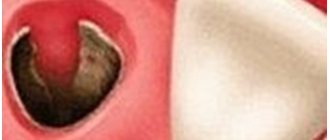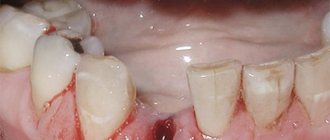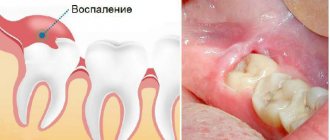From this article you will learn:
- Wisdom tooth removed - how long will it hurt?
- what are the complications?
- How long does it take for gums to heal after wisdom tooth removal?
The article was written by a dental surgeon with more than 19 years of experience.
According to statistics, after the removal of a wisdom tooth, inflammation of the socket of the extracted tooth occurs in 25-30% of cases. For example, after the removal of any other groups of teeth, inflammation occurs only in 3-5% of cases. This is due: firstly, to the higher complexity of removing wisdom teeth, and secondly, to the fact that they are surrounded by a large amount of soft tissue.
The last circumstance is very important, because the presence of moving soft tissues in the area of the extracted tooth socket often leads to the loss of the clot - its loss or even destruction. If the socket of the extracted tooth is not closed by a blood clot, inflammation will inevitably develop in it.
Gums after wisdom tooth removal (normal) –
When wisdom teeth are removed, stitches are almost always required. This is necessary because these teeth are located deep in the soft tissues and in this place the mucous membrane is very mobile. The absence of sutures in this situation can lead to prolapse of the clot and inflammation. But if the patient has a long jaw and there is enough space for the wisdom tooth, the socket will look traditional (Fig. 3).
To learn how the sockets of extracted teeth should normally heal, and how to speed up this process, read the article: “How long should gums take to heal?”
Why complications often occur after wisdom tooth removal -
It must be said that the severity of negative symptoms after wisdom tooth removal directly depends on the degree of traumatic removal. In turn, the incidence of trauma depends not only on the simple or complex position of the tooth in the jaw, but, first of all, on the qualifications of the dental surgeon.
For example, surgeons often spend 1-2 hours trying to remove a patient’s wisdom tooth with just forceps and an elevator - instead of immediately making an incision in the gum, drilling out some bone around the tooth and/or sawing the tooth crown into several parts (after that, removing each root by separately), and spending only 15-20 minutes on it.
Another main cause of complications after complex wisdom tooth removal is the use of a drill by the surgeon, the surgical tip of which is not water-cooled. As a result, a thermal burn of the bone occurs, followed by severe pain and the development of suppuration in the socket of the extracted tooth.
Important: thus, the main causes of inflammation and other complications are the mistakes and negligence of the dental surgeon during the removal process. However, a lot also depends on the doctor’s prescriptions. Correct prescriptions dramatically reduce the risk of developing inflammation of the socket.
Features of cutting through “eights”
A characteristic feature of the third molars is the very late time of their eruption - as a rule, this occurs between 16 and 24 years, and sometimes later [1]. That is why in many languages they are called “wisdom teeth”. Late eruption determines the difficulties that many patients face during the development and appearance of “eights.”
The fact is that by this age the upper and lower jaws, as a rule, are already formed. Therefore, the eruption of “eights” is often associated with unpleasant or painful sensations, and often serious complications. Additional difficulties are caused by individual features of the anatomy of the facial skull, for example, the small size of the jaws, in which there is not enough space for the third molars to fully develop. The reason for this, according to most experts, is the evolution of the structure of the human body [2].
Due to the lack of space for full growth, third molars may not fully erupt (retention) or even change the direction of growth (dystopia). Often they begin to grow not vertically up or down, but at an angle to the dentition. Moreover, the size of the slope can be different and largely determines the possible complications of teething. Both retention and dystopia are considered pathological processes [3].
Among the complications of eruption and development of third molars are [3]:
- acute inflammatory process, up to phlegmon (purulent inflammation);
- formation of pathological bone pockets;
- destruction of hard tissues of the adjacent tooth;
- formation of follicular cysts;
- neuralgic pain;
- osteomyelitis and others.
Prevention of teething diseases consists of monitoring the correct development of the jaws and teething, sanitation of the oral cavity and timely orthodontic treatment, compliance with the rules of oral hygiene
“Retention, dystopia. Teething diseases”, Doctor of Medical Sciences, Professor, Head of the Department of Surgical Dentistry of Moscow State Medical University Panin A. M.
What to do after wisdom tooth removal to avoid complications -
What to do after wisdom tooth removal will depend on the complexity of the removal. If the removal was simple (that is, it was not accompanied by an incision in the gum and cutting out the bone), then standard recommendations after removal will be sufficient. If the removal was difficult or was carried out against the background of purulent inflammation, then the following must be added to these recommendations...
- Antihistamines - these drugs are also called antiallergic. Taking them will reduce the swelling of the soft tissues of the cheek after removal, which will certainly appear the next morning, and in addition, they enhance the effect of analgesics. It is best to take Suprastin. This is a very strong drug, but with a hypnotic effect. Therefore, we recommend taking it in the first 2-3 days after removal shortly before bedtime (once a day).
– it is best to use analgesics from the NSAID group (non-steroidal anti-inflammatory drugs), which have both analgesic and anti-inflammatory effects. These include products based on ibuprofen, ketoprofen, etc.
NSAID-based analgesics
It is best to start taking these medications before your anesthesia wears off. Read about the right choice of medications at the link above. It is best to use them for the first 3 days, then as needed.
- Antibiotics – after a complex extraction, or if the removal was carried out against the background of inflammation in the tooth, taking antibiotics is mandatory. Because After tooth extraction, a bone wound is formed, then antibiotics should be specific to bone tissue. At the moment, the most popular antibiotics among dental surgeons are several drugs.
Firstly, Amoxiclav. The dosage for adults should contain 500 mg of amoxicillin and 125 mg of clavulanic acid. At this dosage, the drug is taken only 2 times a day. However, if you previously experienced diarrhea after taking antibiotics, then it is better to purchase another drug - Unidox-solutab in soluble tablets (taken 100 mg 2 times a day, 5 or 6 days).Very often, doctors also prescribe a drug from the Soviet past - Lincomycin capsules 0.25 (adult dosage - 2 capsules 3 times a day, for a total of 5-6 days). It is inexpensive, effective, but kills the entire intestinal microflora, causing you to suffer from dysbacteriosis later.
Procedures for continuing treatment at home
Treatment of alveolitis at home is carried out when acute symptoms have been eliminated, antiseptic turundas are no longer needed and the goal is to speed up the healing of the hole. For this use:
- Mouth rinses with infusions of chamomile, calendula, and sage. These medicinal plants have anti-inflammatory properties and accelerate healing processes. Rinsing is carried out several times during the day, always after meals.
- Applications with dental adhesive paste Solcoseryl. The drug belongs to the group of tissue regeneration stimulators: it accelerates healing, improves the supply of cells with oxygen and nutrients. The paste has a pleasant mint taste and contains the anesthetic component polidocanol 600. To properly apply the paste, you need to dry the hole with a gauze swab and fill it with Solcoseryl, lightly moisten the paste with water on top. The procedure is repeated several times a day as necessary; the paste is able to protect the socket throughout the day from mechanical and chemical influences.
- Taking vitamin preparations. You can purchase any vitamin and mineral complex at the pharmacy (Vitrum, Duovit, Complivit); Vitamins are taken to increase the body's defenses and shorten the recovery period.
What are the complications after wisdom tooth removal?
When a wisdom tooth has been removed, what to do after removal will directly depend on the symptoms that you experience. It must be said that according to statistics, complications after wisdom tooth removal occur in almost every 4th patient. Most often, patients encounter the following symptoms indicating the development of complications:
- severe spontaneous pain,
- pain when cold or hot water gets on the wound,
- swelling of the soft tissues of the cheek,
- unpleasant odor from the socket of an extracted tooth,
- painful swallowing
- difficulty opening the mouth,
- temperature,
- bleeding,
- the appearance of a hematoma on the face.
Pain after wisdom tooth removal –
Having a wisdom tooth pulled out, how long will it hurt is the most common question patients ask. How much your gums hurt after wisdom tooth removal directly depends on the degree of traumatic removal. Normally, pain after wisdom tooth removal should not be very strong and, once it occurs, it should gradually only decrease. After a simple removal, the pain usually goes away completely in 1-2 days, and after a complex one, normally in no more than 3-5 days.
If you have a wisdom tooth pulled out and the pain immediately after removal is very strong and practically does not decrease in the first days, this indicates that the removal is excessively traumatic and the possible development of inflammation of the socket of the extracted tooth (alveolitis). Here you need to urgently go to the dentist for a second examination. In the worst case scenario, pain can last up to 3-4 weeks.
Symptoms of inflammation of the wisdom tooth socket - upon examination, you can see that the socket is empty, or it is filled with food debris and necrotic decay of a blood clot. Sometimes patients feel sharp/moving bone fragments with their tongue. There is always pain, there is always an unpleasant smell from the hole. The mucous membrane is swollen and red. Such symptoms are characteristic of a mild form.
However, in some cases, inflammation of the socket occurs with abundant formation of pus, swelling of the cheek, difficulty opening the mouth and painful swallowing. And it must also be said that if you experience pain when responding to cold or hot water, this clearly indicates the presence of an exposed area of bone. In any case, only a dentist can help you.
Inflammation of the socket of an extracted wisdom tooth: video
Below you can see what inflammation of the sockets of removed wisdom teeth looks like in the video. Please note that in video 2, when you press on the gums in the area of both removed wisdom teeth, thick pus comes out of the patient’s sockets.
Reasons for the development of alveolitis - if the patient rinses his mouth vigorously in the first days after extraction, this can lead to a blood clot falling out of the socket of the extracted tooth. This leads to inflammation in 100% of cases, because... the hole is immediately filled with food debris and microbes from the oral cavity. But in most cases, alveolitis still develops due to the fault of the doctor -
- traumatic removal,
- fragments or slightly movable bone fragments are left in the socket,
- when cutting out the bone, the doctor used a drill tip without water cooling, which led to overheating and necrosis of the bone,
- the doctor was too lazy to suture the mucous membrane above the hole (in some cases this can lead to exposure of a section of bone in the next few days),
- The doctor did not prescribe antibiotics after a complex extraction, or in the case when the tooth was removed due to inflammation.
Important: alveolitis is the most common complication after wisdom tooth removal. If the described symptoms occur, you should immediately run to the doctor and treat alveolitis. From experience I can say that when a doctor sutures a hole even after a simple removal, the number of cases of alveolitis development is almost zero. In addition, studies have shown that suturing the socket reduces the severity of pain after removal by 30-50%. Therefore, before removal, you should definitely ask the doctor to suture your hole, even if you have to pay extra for it (about 500 rubles for 2 stitches).
Healing process
The stages of wound healing are as follows:
- The first day: the hole fills with blood, which turns into a clot due to coagulation. It becomes the basis for bone formation in place of the void, and also protects against infection.
- 3-4 days: the clot is replaced by granulation tissue. By this time, the severity of pain decreases, and sometimes the area of surgery stops hurting completely.
- Week: a clot remains inside the socket, but most of it has already been replaced by granulation tissue.
- Two weeks: the wound is filled with granulation tissue, turning into bone along the edges and bottom.
- 2-3 months: the hole completely turns into bone.
In order for recovery to occur correctly, you must follow all the doctor’s recommendations.
Swelling after wisdom tooth removal –
If you have a wisdom tooth removed and your cheek is swollen the next day, then in some cases this is normal.
Normally, after simple removal, swelling rarely develops, and most often it occurs in people with an abundance of subcutaneous fat on the face. Such swelling most often becomes noticeable only in the morning of the next day. Normally, after a complex removal, swelling gradually develops immediately and gradually increases, becoming maximum the next morning. Usually the swelling is stable over the next 1-2 days, after which it begins to slowly decrease. If, against the background of swelling, there is no increasing temperature or pain, but on the contrary, all symptoms slowly decrease, then everything is OK.
- When removing an upper wisdom tooth, swelling of the upper cheek may occur (even if the removal was simple). The appearance of edema in this case is due to the fact that the area where the upper wisdom teeth are located is very richly supplied with blood, and therefore swelling of the surrounding soft tissues occurs. If the removal of the upper wisdom tooth was difficult or was carried out against the background of inflammation, then the occurrence of edema is all the more not surprising.
- When removing lower wisdom teeth -
swelling is natural if the removal was complicated (an incision was made, a bone was drilled, a tooth was sawed), or the tooth was removed due to inflammation. Swelling of the surrounding soft tissue near the removed lower wisdom tooth can lead to painful swallowing or difficulty opening the mouth.
When to sound the alarm - if swelling continues to increase over the next 1-2 days after removal, pain and temperature may also increase, pain when swallowing increases, and the mouth opens less and less - all these are unfavorable symptoms indicating suppuration. If you have at least one of the symptoms listed, you need to urgently run to the dentist.
Important: to ensure that swelling does not appear after wisdom tooth removal or is minimal, it is advisable to take antihistamines (Suprastin is best) for the first 2-3 days before going to bed - once a day before bed. Antihistamines have not only an antiallergic effect, but also a decongestant.
Additional physiotherapy treatment (click to expand)
Physiotherapeutic treatment is an important addition to drug therapy; with the help of physiotherapy, the intensity of inflammation can be significantly reduced and healing time can be accelerated. For alveolitis, the following techniques are used:
- UV therapy - the hole is irradiated with short-wave ultraviolet light, which kills pathogenic microorganisms and reduces the level of inflammation.
- SMV therapy is a method of treatment with an electromagnetic field, based on the effect of centimeter waves on the area of inflammation. The procedure helps improve blood circulation and metabolism, due to which toxic substances are removed from tissues faster and regeneration processes are accelerated. SMV therapy also has an analgesic effect.
- UHF therapy – the body is exposed to a high-frequency electromagnetic field. For alveolitis, UHF therapy is used if the patient's regional lymph nodes are enlarged.
- Electrophoresis – medications are injected into inflamed tissue using electrical impulses. For post-extraction alveolitis, electrophoresis is used to reduce pain. For this purpose, solutions of novocaine, lidocaine, trimecaine are used.
- Fluctuarization is a treatment technique with pulsed currents of a sinusoidal shape with a low frequency. As a result of the procedure, blood circulation and lymph flow improves, swelling resolves, and the level of inflammation decreases.
- Laser therapy - the hole is exposed to infrared laser radiation, which has an anti-inflammatory effect, reduces swelling and redness of soft tissues, and accelerates healing.
Temperature after wisdom tooth removal –
- If the tooth was removed NOT due to inflammation - if your wisdom tooth was removed, the temperature may well rise to 37.5 degrees, but only on the first evening.
The body sometimes reacts to injury with just such a low-grade fever, even if the tooth was not removed due to inflammation. This is especially true if the removal was difficult. Normally, the next morning after removal, the temperature should disappear (24stoma.ru). When to sound the alarm: if the temperature does not subside the entire next day after extraction, and even more so continues to increase, then this indicates suppuration of the hole of the extracted tooth. All you need to do is run to the dentist.
- If the tooth was removed due to purulent inflammation, in this case the temperature may be higher than 37.5. But normally, from the next day the temperature should decrease progressively. If it persists and, even more so, increases (this indicates an increase in inflammation), you need to urgently go to the dentist.
Bleeding after wisdom tooth removal –
Usually, in the socket of an extracted tooth, blood clots instantly, but with increased pressure or injury to a large vessel, prolonged bleeding may occur. Bleeding after wisdom tooth removal is not a big deal if it occurs while still in the dentist’s chair. The doctor will then immediately suture the wound with suture material and/or place a hemostatic hemostatic sponge into the socket of the extracted tooth (Fig. 8).
However, very often bleeding after tooth extraction occurs after leaving the clinic. Experienced doctors, to be on the safe side (especially if a large tooth is removed and the patient has a history of hypertension), usually always put 1-2 sutures on the wound, just to prevent bleeding. In addition, suturing allows the wound to heal faster.
Bleeding after removal of the upper 8th tooth: video
More detailed information on the possibilities of stopping bleeding at home is in the article: → “How to quickly stop bleeding after tooth extraction”
Hematoma after wisdom tooth removal –
A hematoma appears due to the fact that a vessel in the soft tissues has been injured. There is no point in blaming the doctor for this, because... When administering anesthesia, the doctor does not see where the vessels pass in your soft tissues. The needle can injure such a vessel and after a few days the skin may appear blue. Gradually it will pass.
However, the formation of a hematoma may require additional measures. A hematoma often festeres after the removal of a wisdom tooth. In this case, already on this day or the next day after removal, the patient experiences swelling of the cheek, a feeling of fullness, pain, and a slight fever. Here you need to urgently consult a doctor, because... when the hematoma suppurates, an incision is required to release the pus.
We answer frequently asked questions from patients -
If you have a wisdom tooth removed: what to do after removal, what to rinse with, how quickly the hole will heal and when it will be possible to treat your teeth... We answer all questions separately.
How to rinse your mouth after wisdom tooth removal -
It is best to rinse your mouth after wisdom tooth removal with the antiseptic Chlorhexidine. This drug is sold in every pharmacy and costs only about 30 rubles per 100 ml bottle. Please note that you can only rinse your mouth slowly, because... Strong rinsing can cause a blood clot to fall out of the socket of the extracted tooth. The latter will lead to the development of inflammation.
How long does it take for gums to heal after wisdom tooth removal?
How long it takes for the gums to heal after wisdom tooth removal depends on the complexity of the removal. Typically, you must wait 1 week to begin treatment after wisdom tooth removal. But after a complex removal, the gums may take longer to heal (up to 10-14 days), which will depend on the degree of traumatic removal. If inflammation occurs in the hole, healing may take 20-30 days. We hope that our article on the topic: Wisdom tooth removal, how much it hurts, turned out to be useful to you!
Sources:
1. Dental education of the author of the article, 2. Based on personal experience as a dental surgeon, 3. National Library of Medicine (USA), 4. “Pathology of wisdom teeth eruption” (Rudenko A.), 5. “Qualified removal of third molars” (Asanami S.).
How many days does it take for the socket and gums to heal?
During a complex operation, the dentist may damage the jaw or push the tooth root into the maxillary sinus. If you do not seek help from a dentist for a long time with such complications, even more terrible conditions appear - gumboil, cyst, osteomyelitis.
Complete healing of the gums after tooth extraction occurs within several weeks. All this time, the mucous membrane hurts a little, but is simply anesthetized with local drugs.
The healing time of the hole is personal for each patient. Recovery takes a long time if care recommendations are not followed. The gums after tooth extraction do not heal even after a couple of weeks, if an infection was introduced during the operation or after the end.
The gum heals in 14 days, and complete restoration of the socket occurs in six months.











